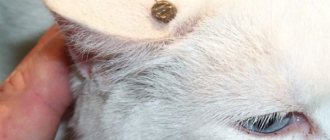Otodectes cynotis is a parasitic disease. The causative agent is an ear mite that is difficult to see with the naked eye. Ear scabies are a fairly common disease among domestic and wild cats. This parasite lives and parasitizes on the surface of the skin, especially in the area of the ears, penetrates the ear canal, actively multiplies and can even reach the eardrum. In advanced cases, the pathogen reaches the brain and invades it, causing severe inflammation and destruction of the brain. The mite feeds on dead and living epithelial cells of the skin of the auricle and external auditory canal; the parasite develops quickly. The life cycle of the parasite usually takes 3-4 weeks. In the external environment or on the body of an animal, a tick can live up to 25 days.
What is otodectosis in cats?
A disease of the outer ear caused by the microscopic parasite Otodectes cynotis, known by such names as otodectosis in cats, parasitic otitis media, ear scabies, and ear mites.
At first, one ear is most often affected, then the disease spreads to the second. When an animal sleeps, it curls up into a ball. Therefore, when a cat has otodectosis, the parasite is able to settle in other areas: the neck, tail, and pelvic area. Outwardly, it may look like dermatitis, allergies, flea bites.
Under good living conditions, proper nutrition, and regular ear cleaning, otodectosis sometimes occurs asymptomatically and goes unnoticed by the owner.
Many cats are carriers of mites without any external manifestations.
However, with deterioration of care, unbalanced feeding, and weakened immunity, ear mites can enter the active stage. Then the disease acutely manifests characteristic symptoms, and treatment directly depends on the condition of the “patient”.
In kittens and young animals the disease is severe. A kitten becomes infected especially quickly from other animals and from its mother.
How do you get infected with otodectosis?
Ear mites in cats can appear if the animal has been walking outside and has been in contact with other cats. Most homeless animals suffer from otodectosis. If you let your pet outside, you should carefully examine it after a walk and do not neglect the rules of hygiene.
There is a possibility of introducing ticks on shoes or clothes. The owner can pet an infected feline or simply walk past a pack of stray animals - and this will be enough for the parasite to travel to a completely domestic cat.
There is a high risk of the disease appearing in those homes where similar cases have already occurred. Ear mites in a kitten are transmitted from the mother, as well as through carpets, various products, home furniture - everything that can accumulate dust particles and microorganisms.
Routes of transmission of ticks from one individual to another
The most common variant of infection is contact with already sick animals. It is enough for one cat to sniff another for several parasites to leave the host and be transmitted to a healthy animal. But there are also indirect methods of infection.
Cat ear mites live up to two months in their natural environment, which means they can be picked up through indirect contact. The disease is transmitted through care products: scratchers, carriers, bedding. Sometimes the infection is carried by fleas or flies.
If a room is not regularly cleaned, the mite settles there, waiting for a host. This should be taken into account when moving or when leaving a cat as a guest for a while.
At elevated temperatures the parasite lives even longer. It stays on clothing and shoes. Therefore, it is important to protect your cats from contact with outdoor shoes and outerwear - ideally, there should be a closed closet in the apartment.
To summarize, we can say that the main “helper” of otodectosis infection is unsanitary conditions. A domestic cat that is carefully cared for, vaccinated and kept clean has the least chance of getting sick.
Progression of the disease in stages
Otodectosis is the most popular skin disease. Ear mites in cats are diagnosed in 85% of cases when breeders treat suspected otitis media. The carpet beetle corrodes the upper surfaces of the epidermis, located on the inside of the shell. The disease proceeds as follows:
- Mechanical injury. At this point, the upper layers of the dermis are damaged. With its powerful mouthparts, the parasite chews the surface, obtaining blood and lymph. The nerve endings become irritated, resulting in severe itching.
- Blood vessels begin to thin out. They become filled with blood, redness and swelling appear.
- You may notice persistent discharge in areas of damaged skin.
- Dark brown scabs form from dead skin cells, as well as other waste products of pests. The whole process is accompanied by the formation of putrefactive microflora.
- There is a gradual accumulation of scabs and crusts, which leads to the formation of a plug. Hearing begins to become dull. If measures are not taken, the eardrum will rupture. The infection opens up to the middle and inner ear.
If parasitosis is advanced, then an active inflammatory process develops in the inner and middle ear. The symptom is a certain behavior of the animal: the sick person walks with his head turned 90 or even 120 degrees. The ear that hurts will point downwards. This process leads to the spread of pathology to the membranes of the brain, sepsis and, as a result, death.
Breeders need to remember that such a simple disease can result in disastrous consequences. But even in advanced cases, it is possible to successfully treat ear mites in a cat and avoid serious consequences.
Briefly about the pathogen
Otodectes cynotis, the causative agent of the disease, is so small that it is difficult to see with the naked eye. Its body dimensions are approximately 0.2-0.5 mm. However, if you examine with a magnifying glass what an ear mite looks like, you can see slowly moving pale yellow, white dots. The parasite feeds on skin scales from the ear canal of animals. Lives on the surface and does not dig.
The life of a tick lasts 3 weeks:
- Females lay eggs and attach them to the skin with a viscous substance and cement them. Each female lays 5 eggs per day.
- After 4 days the larvae appear. Within 3-10 days they begin to actively feed. Then comes the rest phase (from 10 to 30 hours).
- The cycle changes and the larvae move into different stages of development (protonymph and deutonymph).
- While in the deutonymph stage, the larvae attach themselves to the males. And if the deutonymph is a future female, then when she becomes an adult, she already turns out to be a carrier of eggs.
An adult lives on average 2 months. Life outside the animal lasts approximately 12 days.
Clinical signs and symptoms of ear mites
Ear mites are a common cause of ear diseases and infections. They are the second most common ectoparasites (external) found in domestic animals. The most common are fleas. Infestation with them is a very common problem in puppies and kittens. But it affects any age. Symptoms of infestation vary in severity from one pet to another and include combinations of:
- Ear irritation causing ear scratching or head shaking
- Dark, waxy or hard discharge from the ear
- Areas of hair loss due to trauma caused by scratching or over-grooming
- Crusty rash around or in the ear
- An ear hematoma is a large blister of blood on the ear caused by the rupture of small blood vessels between the skin and cartilage - as a result of scratching
Skin lesions most often affect the ear and surrounding skin, but sometimes other areas of the body.
Diagnostics
Otodex disease - often causes ear disease. Other conditions and diseases can cause similar clinical signs. They must be excluded before starting treatment. Diagnosis and diagnosis is carried out by observing the tick. An examination of the animal's ear canal is usually done using an otoscope. Or a microscopic examination of ear discharge is performed. If the ears are severely sore, sedatives should be used to calm the animal for a thorough examination and further treatment.
Otodectosis in cats: symptoms
To feed, the parasite injures the animal’s skin, from which a liquid is released that serves as food for it. Such microtraumas, as well as secretions and excrement released during life, irritate the skin and cause severe, unbearable itching. To alleviate the condition, the animal constantly shakes its head, scratches its ears with its paw, and rubs them against objects.
Due to mechanical damage to the skin on the back of the head and ears, scratches and abrasions are found, and patches of bald patches may appear. If the eardrum is damaged, the pet tilts its head to the side.
If left untreated, the condition worsens, and inflammation gradually develops - otitis media. Therefore, otodectosis is also called parasitic otitis media.
Over time, the inner surface of the ears turns red, the skin in this area thickens and gathers into folds. If the process is not stopped, the inflammation spreads to the eardrum, the inner ear and further penetrates the brain. In this condition, the pet’s body temperature rises, lethargy, convulsions or seizures appear.
The animal's behavior changes:
- sudden movements appear, running to nowhere;
- meowing when scratching ears;
- The cat presses his ears and does not allow his head to be stroked or his ears to be touched.
To understand what is happening to the cat, the owner needs to examine the ears. It will not be possible to examine the parasites. But the signs of ear mites in cats are immediately clear - an atypical color of plaque and severe itching.
If normally a cat's earwax is light with shades of yellow or brown, then with otodectosis the contents of the ear are dark brown and even black, resembling coffee grounds (as in the photo below).
Sulfur in otodectosis comes in different consistencies: dry, wet, loose, hard, pasty. If there is an inflammatory process, an unpleasant odor comes from the ear.
Ways to combat the disease
Treatment options depend on many factors, such as how advanced the disease is and how much the ear canal is affected. After diagnosis, the specialist will prescribe a drug to remove ear mites in cats. Typically therapy consists of several stages:
- clean your ears regularly;
- use medicinal drugs;
- increase the animal's immunity.
Otodectosis should be treated with drops and sprays, and you will have to find an approach to the cat or dog - the procedure is not pleasant. It is important to follow some rules when using remedies against otitis and scabies to reduce the likelihood of relapse.
Cat health begins with hygiene and good immunity.
Treatment rules
Proper care of the feline is the main principle of treatment. It is necessary to protect other pets, otherwise ear parasites will spread to them. What you need to remember before starting therapy at home:
- Joint treatment. If there are other animals living in your house (otitis occurs not only in cats and dogs), it is advisable to treat their ears for 7-10 days. If there are no signs of the disease, traditional medicine will help - they are completely safe even for pregnant and lactating cats.
- Cleaning. It is recommended to thoroughly clean the house, as the larvae could remain wherever the pet walked. Be sure to wash the bed in hot water or use antibacterial agents for treatment. Unfortunately, larvae can remain in fabrics even after washing - it is better to repeat the procedure after a few days. Take the time to wash the curtains, wash your outdoor shoes, and thoroughly vacuum the carpet and furniture.
- Keep an eye on four-legged animals. As already mentioned, ear mites also affect other areas of the body, such as the paws or tail of an animal. When applying medicinal products to the fur, make sure that your pet does not lick them off.
And you always need to be proactive - a strong immune system allows you to avoid many diseases. To effectively boost immunity in cats or dogs, you should choose products with vitamins in consultation with your doctor. Attention is also paid to diet.
SUPERPET species-specific nutrition strengthens the immune system of cats, and otodecosis appears much less frequently in animals on a proper diet. According to the majority of clients whose cats were sick, after switching to SUPERPET, the health of their pets improved. Order the Starter Kit and get your first consultation with a veterinarian for free.
Drug therapy
There are many anti-otodectosis medications for pets, but only a specialist knows which one will help your pet. Before use, be sure to consult with him - all medications for otodectosis have contraindications.
What should you pay attention to when choosing a remedy for this unpleasant disease? First of all, safety, since possible side effects and risks should not exceed the therapeutic effect. Efficiency and convenience are also important, because your four-legged friend does not always like the treatment process. For comparison, here are the most accessible means:
- Decta. Drops with an antibacterial effect against ear mites. It is recommended to drip 4 drops into each ear canal with an interval of 5 days. Typically, a course for pets consists of 3-4 procedures. Contraindications include pregnancy and kittens up to one month old.
- Amidel. A gel that is applied to well-cleaned ears. The drug is used up to five times a week. Amidel shows excellent results in the treatment of many infectious diseases, however, it is prohibited to use it for pregnant cats, nursing cats and kittens.
- Amitrazine. Drops are instilled into the animal's ear canal every 3 days. 4-5 applications of 2-4 drops each are enough to cure the disease. Like many medications, it is contraindicated in pregnant females.
- Otoferonol Gold. Once a week, 2-3 drops are instilled into the affected ears - this procedure is repeated twice. The advantage is that the drug not only relieves the disease, but also heals irritated skin in the auditory organ in cats and dogs. These drops have contraindications: age and pregnancy.
- Aversectin ointment. Apply a thin layer of the substance to the inner surface of the animal's ear. Apply once every 7 days for three weeks. Effectively fights the parasite, as it affects the muscle cells of the tick.
Topical drops are not always good. They often only work during treatment: once the drug is stopped, the ear mites may return. In addition, some of them cause a strong burning sensation when they come into contact with the irritated skin inside the ears.
Experts often recommend taking a closer look at systemic medications, namely drops on the withers against otodectosis in cats and dogs. It is also necessary to mention Gamavit and Tetravit - these are immunostimulants that are administered intravenously. It is unacceptable to use these drugs on your own, since the drug must be prescribed and administered by a veterinarian.
All medications are prescribed by a veterinarian, and treatment must be carried out under his supervision.
ethnoscience
To treat otodectosis at the earliest stage, when there is no visible damage to the ear canal, you can use folk remedies for scabies. It is also advisable to resort to them when ticks appear in pregnant and lactating cats, as well as kittens.
ATTENTION! We strongly recommend that you consult a veterinarian before using traditional methods to combat ear mites in cats.
The first thing you need to do at home is to clean your ears. To do this, you should use a cotton pad, not swabs, as they can easily damage the hearing aid. Soak the swab in warm water, squeeze lightly and gently remove wax and discharge from the ears of cats. Repeat the procedure as necessary.
Then you can start processing your pet’s shells using folk recipes. One of them is a strong infusion of green tea leaves. You need to use loose leaf tea, not bagged tea (it should be without any additives). Brew the leaves, cool so that the liquid is warm, and drop 2-3 drops into the animal’s ears. You need to be careful - you may be allergic to tea.
Garlic ointment and infusion are effective means of combating ear scabies in cats. Pass ½ clove through a press and mix with 2 tbsp. l. vegetable oil and leave for 24 hours, then strain through cheesecloth. Lubricate the cleaned inner surface with the resulting substance once a day. The duration of treatment is approximately a month. Important: garlic should not be used if there is irritation or wounds on your pet’s skin.
Almond oil also shows good results. After cleaning the animal's ears, you need to drop 2-3 drops into the ear canal to treat scabies. Repeat daily for two weeks until ear parasites disappear. Oil can also be used to remove dirt, but frequent use can cause dryness. 3% hydrogen peroxide works well for cleansing.
Let us repeat that the presence of obvious symptoms of otodectosis in cats (severe itching, odor from the ears, dark plaque) is a good reason to put homemade drops away and visit a specialist. The longer you delay this moment, the more time it will take to treat your furry friend.
Diagnosis of otodectosis
In a veterinary clinic, the diagnosis is made based on examination and examination of the contents of the ear under a microscope.
Basic methods:
- Using a special instrument, the doctor sees moving white dots.
- Studying sulfur under a microscope allows you to examine adults, larvae and eggs.
- The "positive ear" method. The doctor wipes the ear canal, and the cat reacts by trying to scratch with its hind paw.
If inflammation (otitis media) has developed, diagnosis becomes difficult. The fact is that with otitis media, an acidic environment is created in the ear, in which parasites die. Therefore, microscopy may not show results.
Also, before treating for otodectosis, the doctor must exclude other diseases that lead to inflammation of the outer ear: allergies, flea dermatitis and other types of parasites.
Symptoms and diagnosis
The owner’s attention is the key to ensuring that any disease is suppressed in the bud in a timely manner. Ear mites are not the most difficult disease to recognize. So it won't be difficult to notice him.
When there is suspicion of otodectosis
You should suspect otodectosis if your furry friend begins to itch frequently. Infection can be determined externally:
- restlessness and shaking of the head, as if a furry friend is trying to throw off some kind of burden;
- dirty brown liquid in the ear canal – it will have a pungent odor;
- the auricle turns red - this is how irritation manifests itself;
- hair may fall out on the outside of the ear and purulent ulcers may appear;
- body temperature periodically rises, accordingly, the animal becomes lethargic - this is the stage of inflammation;
- hearing is partially or completely lost;
- impressive accumulations of sulfur and brown discharge are noticeable;
If the temperature is normal, the pet may meow, run from room to room, and show severe anxiety. In complicated forms, the head begins to tilt towards the affected ear, and the cat itself falls into an apathetic state, loses appetite and moves little. Immediately contact a professional who will help you deal with the situation quickly.
Diagnosis by a veterinarian
Only a qualified veterinarian will determine how to treat ear mites in cats. Before visiting a doctor, the owner can only determine the presence of pests. To do this you will need a cotton swab and a piece of dark fabric:
- use a stick to remove as much of the mass as possible from the ear;
- tap with a stick over a dark surface to shake off pests;
- A bright light is directed onto the area being examined;
- Under a magnifying glass they examine the consistency of the mass: the moving yellowish dots are mites.
Next, you need to urgently go to the doctor. The effectiveness of treatment always depends on how soon the owner seeks professional help. Even if you know traditional methods, you should still ask your doctor how to cure ear mites in cats.
In addition, the veterinary hospital will conduct an examination, a microscopic examination, take a scraping and check the hearing organs. This will not only confirm the diagnosis, but also establish the stage of the disease. According to the neglect, treatment will be prescribed.
How to treat ear mites in cats
Before starting treatment for otodectosis in cats, many factors are taken into account:
- Conditions of keeping (does the cat go outside).
- The severity of the condition.
- Presence of other animals at home.
If there are other pets in the house, then general treatment is carried out. Treatment of the premises and objects is not required, since the parasite does not survive well in the environment. There is also no need to change your diet and lifestyle.
It is more effective to treat otodectosis in a cat that does not go outside and is kept entirely indoors using systemic medications. This is one way to get rid of ticks forever. If the cat is walking and in contact with other animals, parasites are removed with acaricidal preparations that are applied topically.
There is no quick cure for ear scabies in cats. On average, treatment takes 1-1.5 months.
It is important to keep your ears clean throughout your treatment. Otherwise, the cat’s ear mite takes refuge in wax and secretions, and acaricidal agents do not penetrate to the place of refuge.
Diagnostics
Diagnosis of otodectosis in cats. As mentioned above, the tick is quite large and can be seen when magnified with a magnifying glass. But you still need to contact a veterinarian to confirm that otitis media is actually caused by an ear mite (since there are many causes of otitis media in animals) and to make sure that there are no complications in the form of the development of a secondary infection (bacteria). At the appointment, the doctor will collect an anamnesis, perform an otoscopy (examination of the ear canal) - during this procedure, a tick is detected in 50% of cases, the doctor must also take a smear from the ear to check for otodectosis and cytology (stained smear) to check for bacteria.
Folk remedies
It is possible to remove ear mites at home using folk remedies only in the first stages of the disease. In their neglected form they do not produce results.
A well-known method of treatment with folk remedies is the use of sea buckthorn oil. They also use olive, almond, but not tea tree. Some people infuse garlic oil to kill bacteria. Oil may reduce irritation, but it will not get rid of the pathogen.
When ear mites are diagnosed in cats, treatment at home is not recommended. Traditional methods are safe, but ineffective.
Stages of the disease
Once in the ear canal, ear mites irritate the delicate skin by laying eggs. In addition, the movement of the parasite, bites and its metabolic products also cause itching in the animal. The result is redness, bleeding wounds and even ulcers. In the future, swelling may occur, which will negatively affect hearing.
Long-term presence of ear mites in four-legged animals leads to the formation of dark crusts that clog the passage. The danger is that the eardrum may rupture. In advanced cases, the discharge reaches the brain, causing severe inflammation and death. For treatment, it is no longer drops that are used, but more serious drugs, but sometimes they are also powerless.
After laying eggs, the larva hatches - it still has 6 legs, but as it matures (after molting), 2 more legs will appear. The entire process from laying eggs to adulthood takes from 18 days to a month. The life cycle of the parasite is only 2 weeks, but during this time it manages to lay many eggs in the ears of cats and dogs. The dark and warm environment, large amounts of sulfur create ideal conditions for endless reproduction.
Possible complications
With timely treatment, otodectosis does not cause complications.
With a prolonged illness, dangerous consequences are possible:
- Otitis is an inflammatory process accompanied by the release of pus inside the ear. Therefore, if otitis media accompanies otodectosis, then the goal of treatment is not only to destroy the parasite, but to free the ears from germs. For ear mites, cats are prescribed rinsing with antiseptics (dioxidine, chlorhexidine) and a course of antibiotics.
- Hematoma of the auricle. With otodectosis, the pet itches and can damage blood or lymphatic vessels with its claws. If a blood vessel is injured, a hematoma forms. When a lymphatic vessel ruptures, lymph accumulates under the skin. For hematomas in cats, there is no treatment at home, only surgery. The mass is opened and antibiotics are prescribed.
Symptoms of otodectosis
Among cat ear infections, ear mites are the most common. This parasite brings pain, discomfort to the pet, and interferes with maintaining a normal way of life.
Symptoms of otodectosis infection appear immediately and are the same in all cats. These include:
- restless behavior;
- itching;
- the cat often shakes its head and scratches its ears;
- the auricle smells unpleasant;
- sulfur is released abundantly;
- scratches the ears and the skin around them;
- sulfur takes the form of thick black discharge;
- in case of further spread of the tick, profuse scratching of the entire body begins.
Otodectos cynotis, microscopy video
Constant itching causes your cat to scratch regularly. This may cause some parts of the skin to become bald. The balding areas will be red and scratched, which will deepen the level of infection.
Half of the cases of cat ear diseases are the result of mites ingesting them. Therefore, after the first symptoms appear, you need to immediately sound the alarm and take the necessary measures.
Disease prevention
Otodectosis can lead to serious complications, so it is better to prevent the disease than to engage in lengthy and complex treatment. The most reliable method of prevention is considered to be treatment of animals with systemic antiparasitic agents and regular examination of the ears. If any problems are detected, you should immediately go to the veterinarian.
Regular cleaning of premises, cleaning of litter, and treatment of premises with insecticidal preparations play an important role. These actions help to exclude not only the development of otodectosis, but also many other parasitic diseases.
Published in Diseases
Diagnosis of the disease
Based on the above signs, it is not always possible to recognize otodectosis, and in such cases professional diagnosis is required. Some also perform a simple test at home, which is quite effective, but not always accurate. It is necessary to select discharge from the diseased ear and warm it on the surface of black paper. If moving light dots appear, these are ticks. In any case, the final diagnosis must be made by a doctor.
In laboratory conditions, diagnosing the disease comes down to searching for mites in scrapings from the affected surface under a microscope. At the same time, parasites can migrate, so they are not always detected on the first try. Before going to the clinic, you should not clean your animal’s ears for several days - this will increase the likelihood of recognizing the disease.
The tasks of the veterinarians at our clinic in Northern Medvedkovo often include excluding diseases that have symptoms similar to otodectosis:
- Notoedrosis, also known as sarcoptic mange. When ear mites appear, only the inner surfaces of the ears are affected. At the same time, otodectoses do not allow their fellows to enter the captured territory, so the subcutaneous mites of other colonies are located on the outside of the ear or on the face.
- Otitis externa. It may have a non-parasitic etiology, arising due to the frequent use of insectoacaricidal drugs to prevent ticks and fleas in the animal.
- Flea dermatitis, in which the entire ear begins to itch, with the exception of the inner surfaces of the shell.
- Malasseziasis – This disease is caused by a yeast that affects not only the ears, but also the areas surrounding the nose and eyes.
- Allergy, which is characterized by skin rashes around the eyes and mouth.
When it is not possible to determine the exact cause of inflammation, diagnosis is used by treatment: if after acaricidal drugs the symptoms are weakened, the cause is definitely in otodectosis.









